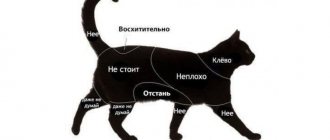It is commonly believed that cats are not trainable, but this is not entirely true. It is possible to teach a cat anything, the main thing is not to command, but to act wiser, conducting classes in a playful way. The game will allow the animal to develop the necessary skills and develop mental abilities. The mustachioed pets are quite capable of mastering simple and interesting commands.
Cat character
A cat is a capricious creature. If you want to teach her tricks, it is useless to order - you need to make sure that she herself wants to comprehend the science of training in a playful way. Take a closer look at your cat, determine what he likes best, and it will be easier for you to choose commands to execute.
Cat learning mechanism
Cats, unlike dogs, are self-sufficient and willful animals. The owner will have to adapt to the mood, character, behavior and individual characteristics of his pet, otherwise training will not bring the desired result.
Training is not based on instilling completely new skills, but on improving existing ones. Does your cat like to jump? Training with hurdles and high obstacles is suitable for her. Does your cat carry things around the house? Then it makes sense to teach her the “Aport” command.
The reward method is very important for cat training. Some cats respond well to treats, while others will do anything for their owner's praise.
Disciplining a cat is difficult, if not impossible - unlike a dog, it chooses its own daily routine and sticks to it. The time for training should be chosen when the cat is full and has slept. The ideal time is when she herself came to you asking to play.
It is known that cats recognize not words, but the intonations of the owner. You need to use this in the training process, learning to intone in a special way in different cases.
The ability to obey a person
Cats' ability to obey humans is specific and clearly manifests itself in childhood, when they are more active and ready to play and explore the world. The kitten learns tricks through play, and then simply reproduces them, to the delight of its owner.
As adults, cats are also capable of learning, but it will take much more time. This is due to the habit of doing things in one’s own way, without paying attention to the requirements of the person.
It will not be possible to force your pet to do something - animals are too capricious. But you can always negotiate or seduce your pet to play and perform tricks.
Felinologists have noticed a trend: the longer a cat lives with a person, the better he understands him. Therefore, it is important to teach a kitten to obey from childhood and spend more time with it, including just talking. With age, your pet will learn to recognize the subtlest shades of voice, and this will help in teaching its commands.
Cat Training Basics
There are a few basics needed to successfully conduct cat training. If these conditions are met, classes will be comfortable for the pet and calm for the owner.
At what age should I start?
There is an established opinion that kittens begin to understand what their owner requires of them from about three months. Accordingly, the optimal age for any training is considered to be from three months to a year. In this case, the peak of activity and perception occurs at 7-8 months. At the same time, the kitten shows a tendency towards certain actions and tricks.
Techniques and techniques
Training a cat must take place in a calm environment, preferably one on one. It is optimal to conduct classes in the daytime or evening, no later and no earlier than 3-4 hours after feeding. The event should be comprehensive, go from simple to complex and not overtire the cat.
The room should be spacious and comfortable for you and the cat. There should be no distracting objects or factors. It is also better to prepare inventory in advance.
Training should take no more than 10 minutes per approach. Number of approaches – 2 or 3 per day. Each “trick” must be repeated at least 4-5 times. This will help bring the execution of the command to automaticity.
The cat needs to be encouraged. The reward is pre-prepared pieces of meat, fish or other delicacies. Those foods that the cat will have to chew are not suitable - it will be distracted from the main training. It is necessary to reward with food exactly at the moment when the cat has performed the trick, but no later than 10-20 seconds later - otherwise the pet will not understand that the reward is connected with its success.
It is necessary to pet the cat and show attention as additional encouragement. Over time, when the cat learns to clearly and quickly follow commands, food should be rewarded every third to fifth time, and the rest - only affection.
Necessary items and materials
Simple tricks do not require special training from the owner or special furniture.
Balls, bows on a string, a hoop (with a diameter of no more than 35 centimeters), a laser pointer, a container for rewarding treats, a skein of woolen thread (which the animal cannot chew off and swallow) may be useful.
The set of items must be selected in accordance with the commands and tricks that were chosen for study. For complex elements, you may need cabinets and chairs or other comfortable furniture - at the discretion of the owner.
All things should be familiar to the cat. If you bought something specifically for classes, first let your pet sniff the new thing. Otherwise, he will be distracted by the introductions and will not pay attention to commands.
Common Mistakes
There are several common mistakes that owners make when training their cats. What not to do:
- Delay classes, increasing their time by more than 10 minutes. Cats quickly get bored with the monotonous execution of commands and tedious games - they begin to get bored and even feel disgusted.
- Forget about rewards or give rewards at the wrong time. It is important that the pet receives the reward in a timely manner - this will help him establish the correct cause-and-effect relationship. If you are late with rewards, the cat may not understand why she was praised.
- Hurry or hesitate to pronounce a command. If an animal carries out a command before a person can pronounce it, there may be a misunderstanding of what was required of it or what it was rewarded for.
The basic principles of cat training can be expressed in one formula: persistent repeated repetition of a specific command + practicing and consolidating the result.
Nuances that should be taken into account
Training a cat is different from training a dog, but there are some differences and some similarities:
- Training any pet requires the use of rewards. In the case of cats, you can use affection, treats, and praise. Felines are quite sensitive to such manifestations.
- Classes should not be too long - a wayward pet may get bored with them. And next time he may refuse to do the exercises altogether.
- The time of the lesson largely depends on the desire of the cat; training can be continued as long as she is interested in it.
- Only the owner has the right to command the pet; other family members, and especially guests, should not interfere. As you know, all cats adhere to a certain hierarchy, and in pets the owner occupies the top level. It is his cat that respects, feels comfortable in his company and allows itself to be controlled.
- Cats are sensitive to their owner’s mood, so it’s best to start training with a positive attitude and goodwill. The pet will definitely pick up on the person’s nervousness and anxiety and may refuse to contact him.
- Under no circumstances should you give commands to your cat while under the influence of alcohol fumes. These animals have a negative attitude towards drunk people and can take a long-lasting offense at the “playing up” owner.
Individual characteristics. When choosing suitable tricks, the owner should take a closer look at the pet’s behavior and take into account his habits and temperament. Some cats like to climb higher, others are haunted by curtains, and others like to run after a ball or candy wrapper. All these inclinations can and even need to be developed, rather than spontaneously developing any skills.
To me!
It’s a completely understandable and simple command that even cats who aren’t very smart can easily understand. And in order for your pet to react to it, it should be rewarded every time after performing the following correctly:
- It’s best to start with the usual “kiss-kiss” or nickname pronunciation. It is advisable to hold a treat in your hands that will attract the cat.
- When she heads in the right direction, it is important to say: “To me.”
- The approaching pet is treated, petted, repeating: “Okay, come to me.”
It is recommended to repeat the command 5-6 times during the day, following the above algorithm.
Sit – lie – stand!
Cats usually master this set of exercises in one or two sessions. To do this you need:
- Lure your pet with a tasty morsel.
- Give his body the desired position, not forgetting to say the command in the process. If you need your pet to sit down, just apply light pressure on the croup. The tidbit is brought a little behind the cat's head. "Stand!" – it is better to lift the cat from a sitting position, lowering the treat below its nose. The cat is lifted, supported by the stomach. "Lie!" – you need to lower the treat lower, gently pressing on the animal’s back. It is recommended to keep the treat away so that the purr cannot catch it without taking the desired position. Then the owner is required to praise the diligent student, treat him and pet him, but only if the exercise is performed correctly.
As a rule, commands are given initially one at a time, with mandatory reinforcement, and only after that should the pet be asked to complete the entire complex.
Jumping through a hoop
A jumping, active pet will most likely enjoy this task. And before using it, you should choose a hoop of a suitable size so that the cat can freely pass through it:
- At first, you should keep the equipment low, you don’t even need to lift it off the floor or other surface.
- A tasty treat is held between the hoop and the muzzle, luring the cat to pass through the hoops.
- While stepping through the hoop, it is important to say: “Up.”
Command "Up!" They are also used for other exercises, for example, when jumping over barriers, moving from one pedestal to another. In the latter case, the treat can be placed on the surface where the cat should land after the jump.
Complicating the command.
When the pet masters the command, the hoop can be raised. It is recommended to do this gradually, increasing the distance by no more than 2 cm at a time.
Over time, the animal will jump high without any difficulty.
If the pet liked the exercise, then the task can be complicated - offer to cover a greater distance. And later - teach him to jump simultaneously from pedestal to pedestal, and then through a hoop or in the reverse order.
What breeds are the best to train?
All breeds handle training differently—and even have different training abilities. Outbred cats differ from purebred cats in their docile nature and quick perception.
Who else stands out for their intelligence and good understanding of people:
- Scottish lop-eared
- cats of this breed love to move, and they are also very attached to their owner and love to spend time with him. This is an optimal breed for training - Scots are able to learn more commands and tricks in less time.
- Thai cat
- active, receptive and perfectly captures the intonations of the owner’s voice. It is easy to learn and trainable due to its abilities.
- Cornish Rex
- cats of this breed perceive training as a kind of game. And they love to play more than others, so they learn well during such games and get less tired of them.
- Abyssinian cat
- an intellectual among his relatives. These cats are able to learn some commands and tricks even without special training or training, simply in the process of playing or communicating with the owner.
Outbred cats exhibit different learning abilities. Basically it all depends on their character and previous life. A cat raised in a family will understand a person better than one that was taken from the street in adulthood.
In addition to the breed, it is necessary to rely on the character of a particular animal - there are lazy Scots and surprisingly active ragdolls. If desired, any cat can be taught at least a small trick.
Natural tendencies to train
Teaching your pet tricks is not as difficult as it seems
First you need to observe how your animal plays, what it can do on its own. Some people like to jump from one piece of furniture to another, others move things to a secluded corner and hide them there from everyone, others like to hide in boxes and bags or do a stand on their hind legs. All these habits can and should be used during training if you want to. All activities should take place in the form of a game, fun, so the cat will be more quickly involved in the process. You can take her favorite toys to help: a wind-up mouse, a ball, a ribbon, and even use the sun’s reflection from a mirror.
Commands for cats
You can specially train your cat in fetching, the commands “Sit” and “Give me a paw”, various jumps and even acrobatic elements.
Sit, stand, lie down
To teach the command “Sit!” you will need to be patient. Unlike dogs, who easily master this command, cats have difficulty with it.
Try the following. Wait until your pet sits down and clearly say “Sit!” Do this several times. Then give the command to the cat in front of you. If an associative connection has not been formed and he does not understand what they want from him, help - press lightly on his body. As soon as he sits down, you must say “Sit!” and reward. In order for the command to work, it will have to be repeated many times.
The commands “Stop!” are learned in the same way. and “Lie down!”: first the animal performs them independently under a voice command, and then the skill of reproducing it in memory develops.
Give me your paw
In the classic version, to teach this command, you need to hold out a piece of your favorite treat on your open palm and say: “Give me your paw.” Instinctively, the cat should place its paw on its palm, but only if it is full. A hungry pet will simply eat the treat.
Later, when the animal has learned the command, it can extend its paw in response to a vocal signal. The treat will remain as a reward at the request of the trainer.
Crawl
Near the lying cat in front of the muzzle, you need to open your hand with a treat and, stroking the pet on the back, gradually move the food away from the muzzle, provoking the pet to crawling movements. Don't forget to give a voice signal.
Bring it or fetch it
Teaching a cat this command is somewhat more difficult. Choose your pet's favorite toy, the one with which he most often spends time. Show it to the cat and throw it away - the pet will most likely rush after it. Wait until he grabs the toy and carries it back, and clearly say “Bring it!”
When the cat is near you, carefully select the object and reward the animal with affection and treats. The command will need to be repeated several times to consolidate the result. If you form the necessary connection with the cat, over time, at the sounds of “Bring it!” he will learn to fetch some items.
Jumping on or over an obstacle
Teaching an animal acrobatic elements is even more difficult, but with great desire and patience this is a completely doable task. Stand in front of the cat with a hoop in your hands and call him. When your pet steps through the hoop, say “Up!” This sound will be the command. Don't forget about the reward.
If instead of jumping through the hoop, the cat tries to go around it, move with him, making it clear that there is only one way through. Over time, your furry friend will learn not only to go through a hoop, but also to jump through it.
You can use other objects that the cat will jump over during the game. The main thing is not to forget to say the command when he fulfills what he wants in a playful manner.
Serve, or "Gopher"
It is necessary to let the cat smell the treat, and then lift it up from its muzzle. The cat will instinctively begin to stand on its hind legs. When you reach the desired position, you need to say a command and give the treat.
If you were unable to achieve the desired position the first time, it is better to repeat the exercise several more times and not give away the treat until your pet manages to stand up.
Voice
This command is best taught not only through training, but also by catching. In the first stages, you will have to tease your pet with a treat until he gives in and meows.
The cat says “Meow” - the owner gives the command “Voice” and gives encouragement - the animal makes the association. This is the easiest way for cats to learn to voice.
Somersault
The attention of a lying cat must be attracted with a treat from the side of its shoulder blades. At the initial stage of training, it is best to gently push the cat with your hand behind the neck or to the side so that it turns over. When the cat does a somersault, you need to say a command and give the treat. This must be repeated until the cat begins to roll over on its own. After this, the command should be spoken in advance.











